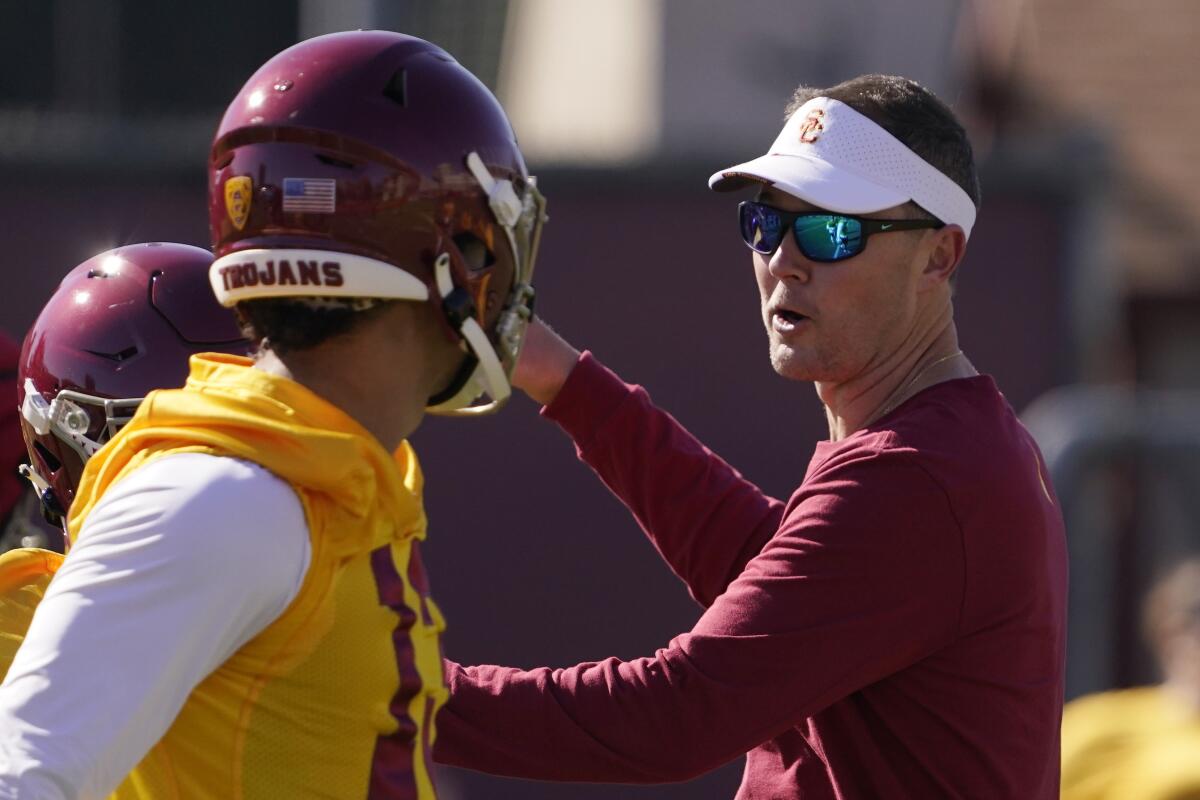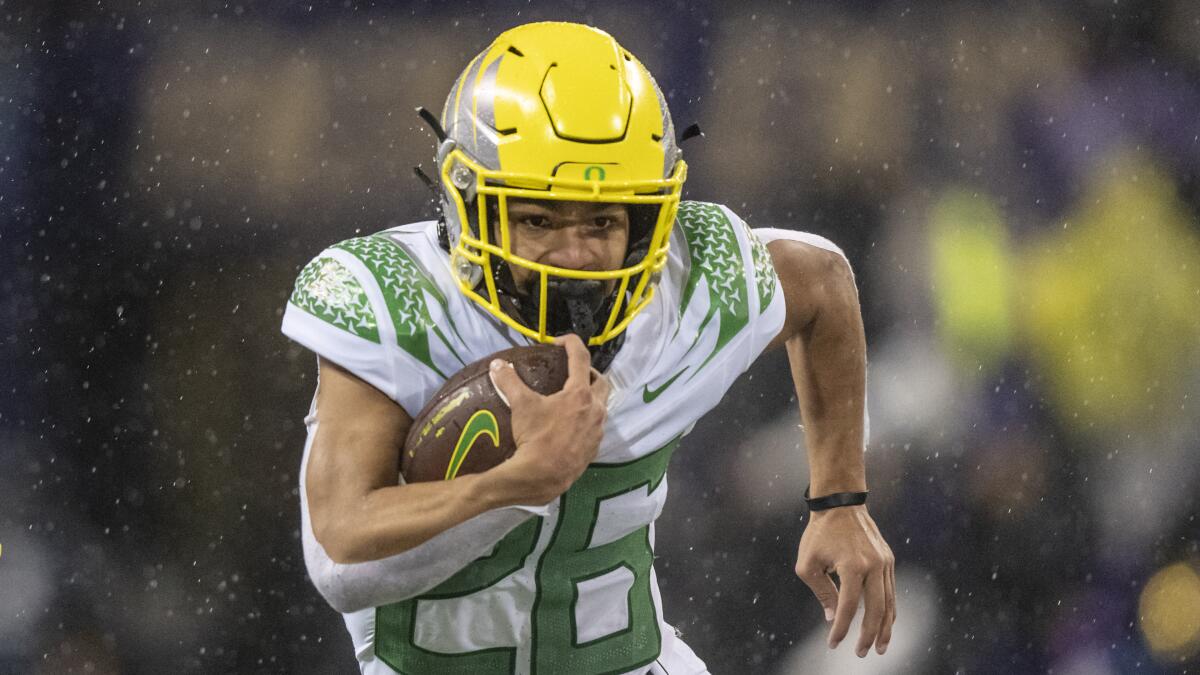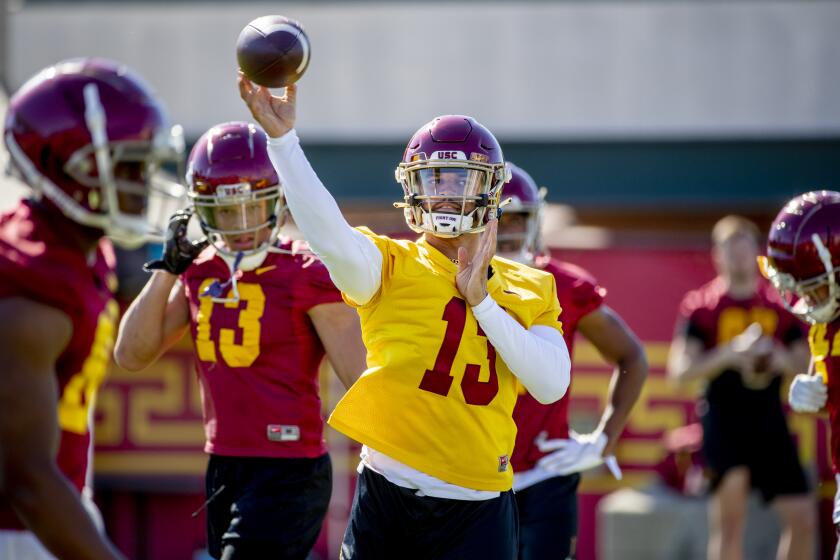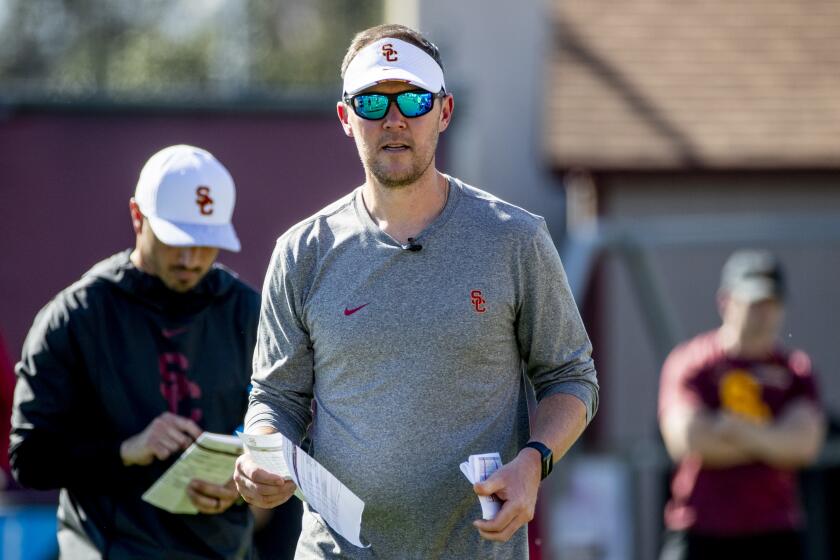No Air Raid? USC could run the ball more often under new coach Lincoln Riley

- Share via
During three seasons spent as the architect of USC’s offense, Graham Harrell went to great lengths to reassure fans his Air Raid could generate a capable run game. Despite that insistence, USC never got it going on the ground with Harrell at the helm. His tenure as offensive coordinator saw the Trojans collectively average fewer than four yards per carry, good for one of the worst rushing stretches in school history.
Lincoln Riley rose up through the same system, with deep roots in the same coaching tree. Like Harrell, who’s now at West Virginia, Riley learned under Mike Leach, one of the Air Raid’s earliest adopters, at Texas Tech.
But when the new USC coach was asked to explain his system earlier this spring, he wondered aloud if the label often ascribed to his offense even fit at all.
“The Air Raid stuff came from all of our background at Texas Tech,” Riley said. “Over the last seven years, we’ve had the highest yards per carry of any college football team in the country. We’ve [run] the ball at a high level for a long time, so I don’t know that Air Raid really fits anymore to be honest.”
If USC can successfully reinvigorate its rushing attack, it won’t matter what Riley calls his system. During the last four seasons, USC has ranked 82nd, 120th, 119th and 107th in rushing nationally. The Trojans have averaged 200 yards rushing or more per game just once (2016) since the heyday of Reggie Bush and LenDale White.
Riley, by comparison, hit that benchmark in each of his first three seasons as Oklahoma’s head coach and both seasons he spent as the Sooners offensive coordinator before that. Last season, only six teams averaged more yards per rushing attempt than Oklahoma.
USC’s Caleb Williams is a dual-threat quarterback but coach Lincoln Riley says his next progression is to stay longer in the pocket to let plays develop.
All signs point to more of the same at USC, where Riley has already rebuilt the running back room, adding experienced transfers in Travis Dye and Austin Jones, both of whom have impressed through spring camp. Dye led the Pac-12 in all-purpose yards a year ago.
“I believe you have to run the football to win championships, to be a championship football team,” Riley said. “It’s something we’ve been pretty decent at in our past. I think it’s something this school, when you look back at its championship seasons, a strong running game has been a part of that.”
So what has made Riley’s run game so strong? USC running backs coach Kiel McDonald, who’s new to Riley’s offense, says it’s his ability to adapt in a hurry.
“There’s so many answers, and those answers come on the fly,” McDonald said Tuesday. “They come very, very quickly. The run game, it’s not just a zone that goes with an Air Raid offense, there’s a lot more moving parts than that. I see why they’ve been so successful at Oklahoma.”
The Sooners didn’t have one single formula for success on the ground during Riley’s tenure. Some seasons, he clung to a committee approach. Others, he relied on a workhorse. Oftentimes, a dual threat quarterback would add a wrinkle to the run game, freeing up room for other backs.

That should be the case again this season with Caleb Williams at quarterback. But how the rest of USC’s rotation might shake out remains a mystery. Dye and Jones have split carries this spring with Darwin Barlow, the sole returning back from last year’s rotation. That trio will be joined this summer by top recruit Raleek Brown, who’s expected to step into an all-purpose role as a freshman.
A committee approach could also be in the cards to start the season. But at Utah, where he worked as running backs coach since 2017, McDonald has always relied on one back more and more as the season went along.
He’s alluded to similar plans this spring for USC.
“Zack [Moss] was a 20-carry guy. Ty [Jordan] was a 20-carry guy. Tavion [Thomas] turned into a 20-carry guy towards the end of the year,” McDonald said. “If you earn it, and you’re the guy, then you’re the guy. That’s for sure. I believe at some point someone is going to step up. But we’re fortunate enough to have three really good players. I think we could be in a situation like that.
“But somebody always gets to the top.”
USC coach Lincoln Riley would like there to be more rules regulating name, image and likeness deals in an effort to separate it from recruiting.
Max weight
By the end of his freshman season, Max Gibbs tipped the scales at 410 pounds.
Gibbs is still the biggest player on USC’s roster, but much has changed for the sophomore. USC’s new staff put him on a new training regimen, with a new diet and a new workout routine. Midway through spring, Gibbs is feeling reenergized, down 40 pounds to a much more manageable 370.
A smiling Gibbs said Tuesday that his weight loss has helped him trust USC’s new staff — and just to feel better, in general.
“Man, I feel way lighter,” Gibbs said. “It makes me really happy. It makes me want to keep going.”
More to Read
Go beyond the scoreboard
Get the latest on L.A.'s teams in the daily Sports Report newsletter.
You may occasionally receive promotional content from the Los Angeles Times.









